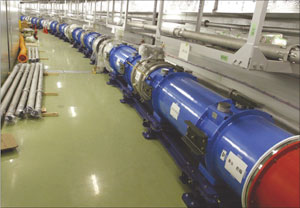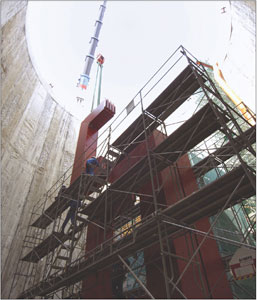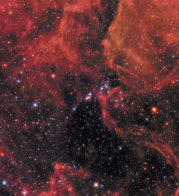Construction is in full swing in Japan on the new facility to send neutrinos from J-PARC to the Super-Kamiokande detector
T2K is a second-generation, long-baseline, neutrino-oscillation experiment that will study the nature of neutrinos. A neutrino beam generated by the high-intensity proton accelerator of the Japan Proton Accelerator Complex (J-PARC) at Tokai will travel 295 km to the 50 kilotonne water Cherenkov detector, Super-Kamiokande, which is located about 1000 m underground in the Kamioka mine.
The J-PARC neutrino facility will follow the standard route for making a neutrino beam. This begins with an intense proton beam that strikes an appropriate target to create many secondary particles, including pions and kaons, which in turn decay to muons and the desired muon-neutrinos. The secondary particles pass through a decay volume followed by an absorber, or beam dump, which removes all but the muons and neutrinos from the beam. A further absorber – the rock in the Earth between the beam dump and the detector – removes the muons to leave only the neutrinos.
At J-PARC the primary beam line will consist of superconducting combined-function magnets for the arc section, with normal conducting magnets for fast extraction and the final focus. The target will form part of the secondary beam line, which will also contain the magnetic horn system to focus the pions and kaons into a beam, the decay volume, and the beam dump and muon monitors. The horn system being used consists of three horns, the first being combined with the target system. In addition, buildings for services such as power supplies and cooling water systems for the beam lines are under construction, as well as the building and underground pit for the near neutrino detector, ND280, which will monitor the neutrinos.

Image credit: KEK.
Work on the primary beam line is making good progress. The normal conducting magnets are all in place, and the installation of cabling and piping is under way. In the arc section, 12 of the 14 doublets of superconducting magnets have been installed, together with beam position monitors. The survey and alignment took place in April, with remaining work carried out after the commissioning of the main proton ring at 3 GeV. This saw the successful injection of 3 GeV protons from the rapid cycling proton synchrotron into the main ring on 22 May. Commissioning to 30 GeV will take place from December 2008 to February 2009, and the commissioning of the fast extraction for the neutrino beam should start in April 2009.
For the neutrino beam line, both the helium vessel for the decay volume and the target station (where the target and horn system will be installed) have been completed. Civil engineering around them continues on the target station building and the pit for the beam dump and muon monitors. The installation of the neutrino equipment into the target station should begin in July. The complete arrangement for the third horn was assembled at KEK in Tsukuba to debug the remote handling system that will be used for installation and maintenance. Tests on the operation of this horn began in April, while tests on assembling the target system and the first horn are scheduled for completion by July.
The beam dump consists of 14 core modules composed of graphite blocks and aluminium cooling plates. The modules were completed by the beginning of April, and by November they should be assembled together to form the beam dump, prior to installation in the beam-dump pit. Construction of the muon monitors is also under way and they are scheduled for testing with beam in July.

Image credit: KEK.
The pit for the neutrino monitor became available in April, so installation work could begin on the large magnet for the ND280 near detector, which is being assembled below ground before construction work begins on the surface building. The magnet has been donated by CERN, having been used in the UA1 experiment, for which it was built, and subsequently in the NOMAD neutrino experiment. It consists of 16 C-shaped yoke pieces, together with two carriages for the yokes, rails and other components. For the journey to Japan the yokes were disassembled into 32 short pieces and 16 long pieces, so as to fit into standard containers.
The various pieces travelled to Japan in three shipments, mainly by sea. The first and second shipments were for the yokes, carriages and jigs etc, while the third contained the delicate coils. The first shipment arrived at Japan’s Hitachinaka port on 18 March, bringing 24 short yoke pieces in 12 containers each 20 ft long, together with the two carriages each in a 40 ft container, and a third 40 ft container with items such as jigs. The two carriages, jigs and other items were transported from the port to J-PARC on 28 March in readiness for installing the magnet in the neutrino monitor pit. The task of unloading the 24 short yoke pieces at the area began on 1 April and on 3–4 April they were moved to the neutrino monitor area.
The second shipment arrived at the port on 10 April, bringing the remaining eight short yoke pieces and the 16 long yoke pieces. The short yoke pieces were taken into the neutrino monitor area on 19 April, and by the end of the month, the mobile crane had unloaded the long yoke pieces and carried them to the area, ready for re-assembling the short and long pieces into the16 yokes prior to installation in the pit. The coils, in the third and last shipment, were due to be delivered to the neutrino monitor area in the middle of June, for subsequent installation in the magnet yoke.

Image credit: KEK.
The survey to put reference lines on the floor of the neutrino monitor pit was carried out soon after the site became available, and by 14 April the rails for the yoke carriages were in position. The carriages were then lowered into the pit and mounted on the rails. The system for aligning the yokes was also set up, ready for when the yokes are installed on the carriages.
The 16 full yokes are being assembled at a rate of one per day. After they are all assembled, they will be lowered into the pit and mounted on the carriages using the alignment system. The plan is to complete installation of the yokes by the beginning of June. By this time, the coils should have been delivered from the port to the neutrino monitor area, in time for installation into the magnet yokes. Complete installation of the magnet in the neutrino monitor pit is scheduled for the end of June. The complete J-PARC neutrino beam facility and the near detector ND280 should then be ready by March 2009 so that the T2K experiment can start in April 2009.
• The T2K collaboration thanks the CERN management and European colleagues for their generosity in donating the UA1 magnet and their hard work in its preparation at CERN and J-PARC.





